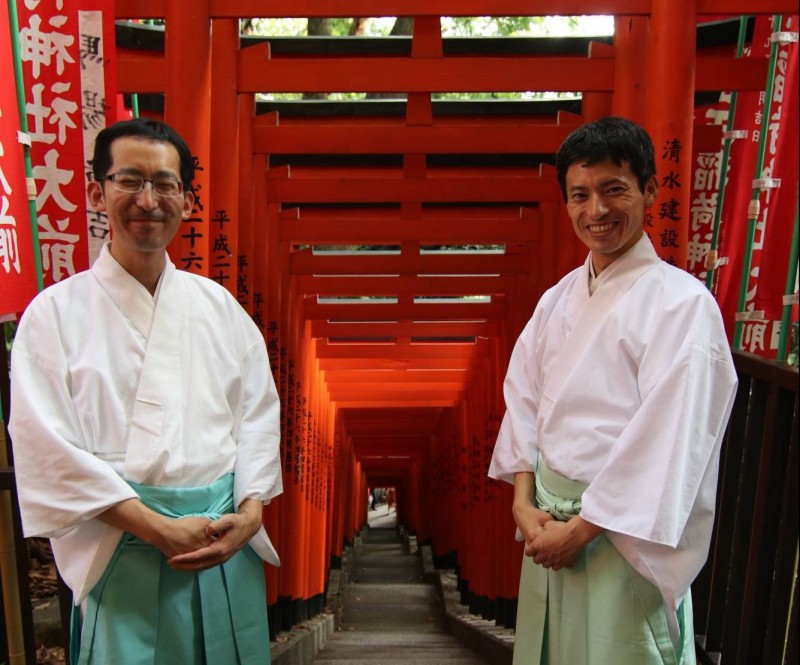Green Shinto has covered the current boom in ‘power spots’ on several occasions, and an overview of how, when and why it developed can be found in a previous posting here. Tokyo Daijingu is Kanto’s most famous example, though Hie Shrine also has its fans, as revealed in the article below.
**********

Hie Shrine priests Hiroyuki Korehisa (left) and Hiroyuki Uchida stand in front of Sanno Inari Shrine’s torii. | Photo by Kit Nagamura
Akasaka: Sublime and surreal spots in Tokyo’s government district
BY KIT NAGAMURA SPECIAL TO THE JAPAN TIMES AUG 11, 2017
A diplomat friend and I enjoy lunch at the Akasaka Capital Tokyu Hotel, in the governmental hub of Tokyo. As we part, he tips me off that there’s a little-known footpath from the hotel, leading uphill to the Hie Shrine, one of Tokyo’s most important Shinto sites. I decide to climb the discreet bamboo-shaded path for a quick visit.
By the time I reach Hie’s Shinmon gate, which sports elegantly layered roofs that lift at the tips like the wings of a heron, I find I’ve also climbed above the sounds of the city. I’m admiring the peaceful grandeur when a bit of monkey business catches my eye.
Where most shrines have guardian figures in the form of foxes or sacred komainu (lion dogs), Hie sports stone monkeys on either side of the haiden [Worship Hall], and its zuijin (warrior figures inside the main gate) are also larger-than-life simians. I head to the shrine offices to investigate.
Meeting with priests Hiroyuki Korehisa, 34, and Hiroyuki Uchida, 39, I get the scoop on the shine’s history, which is believed to date from the Kamakura Period (1185-1333), and enshrines Oyamakui-no-kami, the god of Kyoto’s Mount Hiei. In 1478, brilliant engineer and local lord Ota Dokan requisitioned the shrine to protect a castle he was constructing.
“The shrine has moved around a lot from its original location on the castle grounds to a new spot just outside the castle moat, in 1607, so that locals could visit it freely,” Korehisa explains. “It was reduced to ashes in the city-wide Meireki Fire of 1657, but rebuilt again in this location in 1659.”
As we stroll the grounds, I learn the shrine was again decimated in World War II bombings and the current concrete buildings were erected in 1958. To this day, though, the shrine’s mandate still includes protecting the castle grounds of old, today occupied by the Tokyo Imperial Palace. A plaque on the shrine’s inner gate proclaims its mission: Kojo no shizume (“Bringing peace to the old castle”).
I suddenly remember to inquire about the monkeys. The courtyard of pebbles crunch underfoot as the two priests and I walk over to the stone guardians. “It’s really difficult to explain Shinto gods,” Korehisa sighs. I nod and pat the sweat off my brow, knowing how enmeshed the stories can get. Korehisa points out that the monkeys are clad in hats, clothing, and even split-toed tabi socks. “The monkeys that inhabit Mount Hiei are believed to be the spiritual connectors between humans and the gods,” he explains with bracing brevity.
The male monkey, according to Korehisa, is known as Masaru. “You can hear the word for monkey, saru, in that name, right?” Depending on the Japanese characters you use to write Masaru, the name can mean “to win or excel” or “kindness,” or even “to send evil away quickly,” he says. The female monkey, he points out, clutches a small baby. “Japanese believe that monkeys have relatively easy pregnancies, and monkeys share the burden by raising their young in groups. That’s why people pray here for things like safety, easy childbirth and social kindness toward one another,” he says.
We pass tall storage shelters for the shrine’s mikoshi and dashi (portable shrines and floats) used in the biannual Sanno Matsuri, one of Tokyo’s three major festivals (along with the Kanda and Fukagawa festivals). Finally, we stand before a small fox shrine.
“The Sanno Inari is the only building that has survived here from 1659,” Korehisa says. “It has been repainted recently, so it looks new, but it’s over 350 years old.”
I’m delighted the little shrine outfoxed the flames, not least because it is the reason behind a beautiful tunnel of 90 vermilion torii that lead to it. “This entrance has become a popular power spot,” Korehisa says with pride, “and it was even used recently for a Vogue fashion shoot.”

Leave a Reply